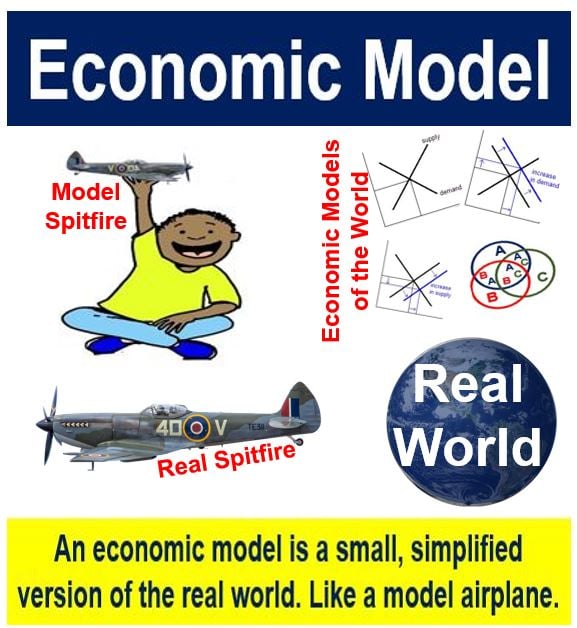What is an economic model? Definition and meaning
An economic model is a theoretical construct that represents a process by a number of variables and a set of quantitative or logical relationships between them – to determine what might happen in different scenarios or at a future date.
It is essentially a simplified framework used for describing the workings of the economy.
An economic model is what an economist uses to make a number of simplified assumptions and then sees how different scenarios might play out.
Milton Friedman (1912-2006), an American economist who was awarded the 1976 Nobel Memorial Prize in Economic Sciences, argued that you should not judge economic models according to the validity of their assumptions, but rather on how accurate their predictions were.
A champion billiards player, Prof. Friedman explained, might not know much about the laws of physics, however, he acts as if he is an authority on them. Therefore, his behavior could be accurately predicted if we used a model that assumed he had Einstein-like knowledge of the laws of physics.
 The world is a complex place, full of confusing data. We create economic models to make sense of some of that information. Basically, an economic model is a smaller and simplified version of the real thing – the real world. Just like a model of a spitfire is a smaller version of the real airplane.
The world is a complex place, full of confusing data. We create economic models to make sense of some of that information. Basically, an economic model is a smaller and simplified version of the real thing – the real world. Just like a model of a spitfire is a smaller version of the real airplane.
In the same way, if we assume that people’s goals are, for example maximizing profits, even if they are unaware that this is their aim, we are able to accurately predict their behavior when making economic decisions with a model (that makes this assumption).
Simple vs. complex economic model
It is easier to make accurate predictions with simply-designed economic models than with complex ones.
Economists often create models in order to simplify their data so that non-specialists can understand them.
If a specialist has to make a presentation to a group of lay people, using economic models is an effective way of getting everybody to understand the overall message, or the conclusions of a study.
“An economic model attempts to abstract from complex human behavior in a way that sheds some insight into a particular aspect of that behavior. This process inherently ignores important aspects of real-world behavior, making the modeling process an art as well as a mathematical exercise.”
“The expression of a model can be in the form of words, diagrams, or mathematical equations, depending on the audience and the point of the model.”
 Economic models help us logically isolate and sort out complicated chains of causes and effect and influence different interacting elements within an economy. Through the use of models, we can experiment, at least logically, producing a number of scenarios that help decision-makers evaluate the effect of alternative options. (Data Source: pages.hmc.edu)
Economic models help us logically isolate and sort out complicated chains of causes and effect and influence different interacting elements within an economy. Through the use of models, we can experiment, at least logically, producing a number of scenarios that help decision-makers evaluate the effect of alternative options. (Data Source: pages.hmc.edu)
Purposes of economic models
Models are created and used for two main purposes:
– Simulations: how would a country, region or the world change relative to a counterfactual if we assume a change in one or another variable? A ‘Counterfactual’ relates to or expresses what is not the case or has not happened. An example of a counterfactual statement is: “If kangaroos had no tails they would lose their balance,” (kangaroos do have tails).
– Forecasting: such as what will the USA, UK, Europe, North America or the world look like in 2040?
Accuracy of simulations vs. forecasts
Economic models are super tools for simulations, because we know everything that currently happens in an economy – we take them as a ‘given’ – and can create different scenarios, such as ‘How would the economy respond to a massive fall in energy prices?”
However, economic models are not so good at predicting what will happen in the future, because when we forecast, there is not much that we can take as given. How different variables might behave in future is all a matter of calculated guesswork.
The further into the future our predictions are, the greater the structural uncertainties become. The chances of accurately forecasting what the world will be like in 10 years’ time if average global temperature rise by 2°C is greater than doing the same for 100 years’ time.
The term may sometimes refer to what makes a specific economy function. For example, the German economic model is based on high exports.
Video – What is an economic model?
In this video, Stephen King explains what an economic model is and what their roles are in microeconomics. He uses the perfectly competitive market model as an example.

